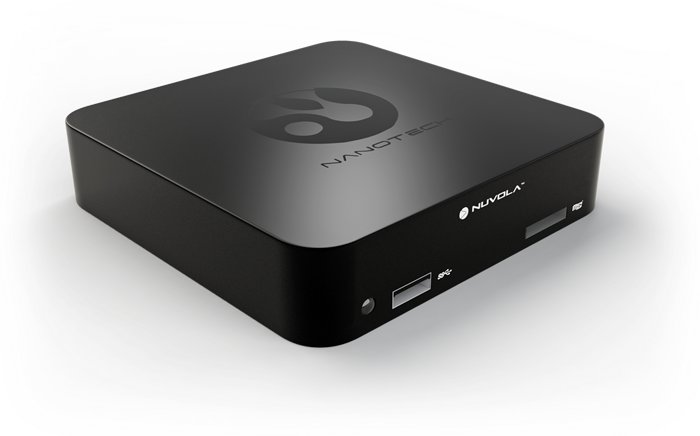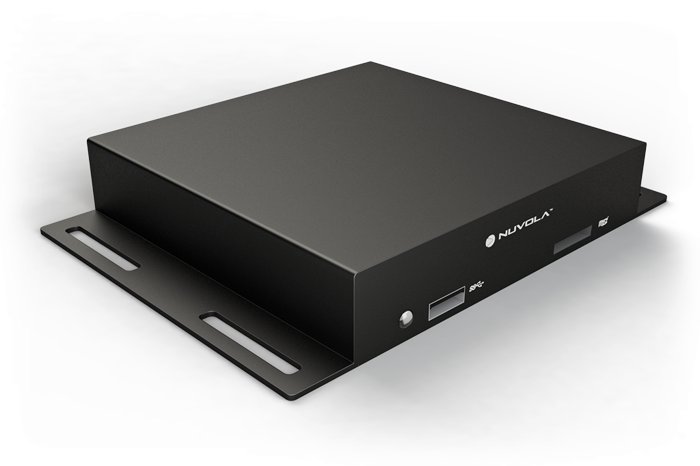NanoTech Entertainment is preparing to launch Nuvola NP-1, and its commercial version Nuvola MP-C, an Android 4.2 set-top box powered by Nvidia Tegra 4 SoC with 2GB RAM and 16GB Flash, and capable of streaming 4K2K videos. The company also promised to upgrade the box to support HEVC (H.265).

Novula NP-1 Specifications:
- SoC – Nvidia Tegra 4 quad core processor with 72-core GPU
- System Memory – 2GB DDR3
- Storage – 16GB Flash Memory + microSD slot
- Connectivity
- 10/100/1000M Ethernet
- Dual Band 802.11n 2×2 Mimo Wi-Fi
- Bluetooth 4.0
- Video Output – HDMI 1.4
- Supported Video Formats – MP4, MKV, AVI, MOV, OOG (H.264)
- Supported Audio Formats – AAC, FLAC, MP3, WAV
 Video Streaming Support – 4K UltraHD (3840×2160), HD (1920×1080), SD (720×480)
Video Streaming Support – 4K UltraHD (3840×2160), HD (1920×1080), SD (720×480)- USB – 1x USB 2.0, and 1x USB 3.0
- Power Supply – 5V
- Dimensions – 90mm (w) x 100mm (l) x30mm (h)
The device runs Android 4.2, comes with pre-installed applications such as NetFlix, Hulu, Amazon Prime, YouTube, XBMC, and more. Nuvola NP-X set-top boxes are sold with a small IR remote as shown on the right, but the company also provides other accessories such as the dual sided RF-10 remote with speaker and microphone (which just looks like Mele F10 Pro), and GP-1 Gamepad,a Buetooth game controller that looks familiar (to an XBOX-360 controller).
Novula NP-C has the same specifications, but features a rugged casing.

The device is not available yet, but you can pre-order it for $299, with shipping expected next month. Before you spend that kind of money, you may want to make sure it can output to 4K2K, as it’s NOT a guarantee. For example, all AllWinner A31 mini PCs and set-top boxes can decode 4K2K videos, but none of them can output 2160p to your TV, the limit is 1080p60, and in many cases, it’s just set to 720p. However, if Nuvola NP-1 does indeed output 4K2K via HDMI, it’s truly a unique product, especially with HEVC codec support coming up. The company does not take rooting lightly, as doing so will void your warranty. No need to ask what happens to your 1-year warranty if your try a custom ROM, and/or load Linux on the device.
You can find more information on Novula website.
Via AndroidPC.es

Jean-Luc started CNX Software in 2010 as a part-time endeavor, before quitting his job as a software engineering manager, and starting to write daily news, and reviews full time later in 2011.
Support CNX Software! Donate via cryptocurrencies, become a Patron on Patreon, or purchase goods on Amazon or Aliexpress





Tegra 4 don’t support H265.
it also don’t support openCL than you can’t make it software(GPU) way 🙂
@m][sko
I’ve just seen Rockchip plans to support 1080p H.265 on RK3188 by software (They already have 720p in their office), so I guess Tegra 4 should be able to handle that, at least 1080p.
These guys were originally using an allwinner a31 chip and charging $300 for the 4K suckers, they got called out on it and there was a few weeks later they are now using a Tegra 4 chip, it’s at least a step up from before.
Hence the F10 looking remote and CAD mockups of those box.
But yeah I’d be sceptical of any box with 4K claims, HDMI 1.4 can only output 4K at 30fps, you need Displayport 1.2 for 4k at 60fps or the next HDMI 2.0 standard. Also Sony has been messing about with HDMI 4k HDCP breaking support so all their 4K TV’s need new logic boards put in them to work with Sony 4K media player.
Basically 4K is a total mess.
@cnxsoft
I did test with libav/ffmpeg h264 sw decoder on dual core amlogic MX and
i can get 720p30 on dual core with 160% cpu load
http://corecodec.com/
has much better implementation at least on X86 than libav/ffmpeg
I hope that we will see some demo
Bud I am really skeptical as all hw decoders in SOCs are pure DSPs without any possibility to do any upgrades
@m][sko
I assumed the promised H.265 upgrade would just be a firmware upgrade with software decode.
Nvidia totally overestimated their ability to force the ARM market to use their old tech non-unified GPUs and then dominate the ARM market: With that GPU the only alternative to Samsung A15 silicon is now beset with a liability, one too many in the case of Nvidia, who has evidently managed to turn every product equipped with a Tegra SoC into a disaster (except perhaps the Nexus 7).
The Tegra 4 seems to have an ecosystem of zero, the Shield may never ship, because an ecosystem of 0.0001 isn’t enough to live on and the only sensible thing for Nvidia is to get out of that business while they have any money left.
Good thing they won’t even promise to publish source code, because that might actually make this “device” just a bit interesting.
On the other hand, they’d need Nvidia to provide it first, which Nvidia never did before. Most likely they can’t ever because it might show, that they are using tons of unlicensed technology.
That’s really the greatest pity of it all: The small windows of opportunity for the A15 architecture is closing already with A57 on the horizon. Samsung fumbled the ball, keeping such close taps on all Exynos 5 SoC, that they never really had a chance to show their stuff (just think of A15 based ODROIDs! The dual core at 28ns, not this octa-monster!).
Tegra4 could have made a splashh there, if only it wasn’t done by Nvidia and handled in the typical Nvidia manner.
The Rockchip 3188 is currently rolling up a market (the $100 post-PC device), in which it rightfully shoudn’t even exist, because there is better hardware, that just isn’t sold at a proper price to the open market with all the proper sources, tools and help to make it a success.
I very much doubt this “device” is anything but a hoax, or will ship or will see a couple of years of support.
At $50 I might not care at $300 this device is an insult in any case.
As a tech engineer from one of the most prestigious companies globally. I find this price to be “over priced”, the tegra 4 is primarily made for mobile devices, such as phones, gps, or any other portable devices. By engineering this onto a larger device, it will backfire and the device will cause over heating, which will lead to a fail of the core. A reasonable price would’ve been $150 at most. $300 is still too much.
@Jesse Andrews
Dude, really? A “tech engineer,” as opposed to what, a sanitation engineer? “One of the most prestigious companies globally?” That just sounds silly.
Oh, and the idea that putting a chip intended for mobile devices into a larger enclosure is going to cause overheating and failure, please, a larger device can simplify thermal management. You think it is easy to pack a powerful SoC, a cellular radio and a Li-battery into something the size of a modern smartphone and operate it without it becoming unpleasantly warm?
And as for pricing, why do so many “tech engineers,” seem to thing that the only way to price things is based on a small markup over the cost of components? Isn’t it smarter to spend your tech engineering efforts on product segments where you can command decent margins? Business generally try to make a profit, you know. If they don’t they go out of business.